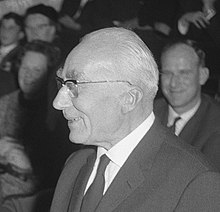Piet Zwart
| Piet Zwart | |
|---|---|
 |
|
| Born |
28 May 1885 Zaandijk, Netherlands |
| Died | 24 September 1977 (aged 92) Wassenaar, Netherlands |
| Nationality | Dutch |
| Education | Architect, Photographer |
| Known for |
Typographer, Graphic designer, photographer, Industrial designer |
| Notable work | NFK Catalog, Book of PTT |
| Awards | Designer of the 20th Century by Association of Dutch Designers |
Piet Zwart (Dutch pronunciation: [ˈpit ˈsʋɑrt]; 28 May 1885 – 24 September 1977) was a Dutch photographer, typographer, and industrial designer.
Piet Zwart was a Dutch designer born on May 28, 1885 in Zaandijk, in Noord-Holland (North Holland). He trained as an architect, and began graphic design projects at age thirty-six. His training as an architect included designing furniture and interiors. He was influenced by the De Stijl movement, which focused on the essentials of form, colour and line, but later moved to a more functional design aesthetic. In the early 1920s Zwart received his first typographic commissions from Laga, a flooring manufacturer. Zwart had no formal training in typography or printing, so he was uninhibited by the rules and methods of traditional professional practices. Zwart regarded typography as an important cultural force of the 20th-century.
Zwart attended the Rijksschool voor Kunstnijverheid Amsterdam (National School of Applied Arts, Amsterdam), which later merged into the Amsterdamse Hogeschool voor de Kunsten (Amsterdam University of the Arts), from 1902 to 1907. He studied a diverse range of art related subjects including painting and architecture, and he was introduced to the principles of the English Arts and Crafts movement.
From 1908 he taught drawing and art history lessons at the Industrie- en Huishoudschool voor Meisjes, (Industrial and Domestic School for Girls) in Leeuwarden. In 1913 he moved to Voorburg and returned to study, attending the Technische Universiteit Delft (Delft University of Technology) from 1913 to 1914.
From 1919, while continuing to work as an independent designer, he began teaching at the Rotterdam Academy of Visual Arts, now the Willem de Kooning Academy. He was dismissed in 1933 because of what were considered his radical ideas on education. Zwart's ideas were similar to those of the Bauhaus art school in Germany, where, in 1929, he gave a series of guest lectures.
...
Wikipedia
